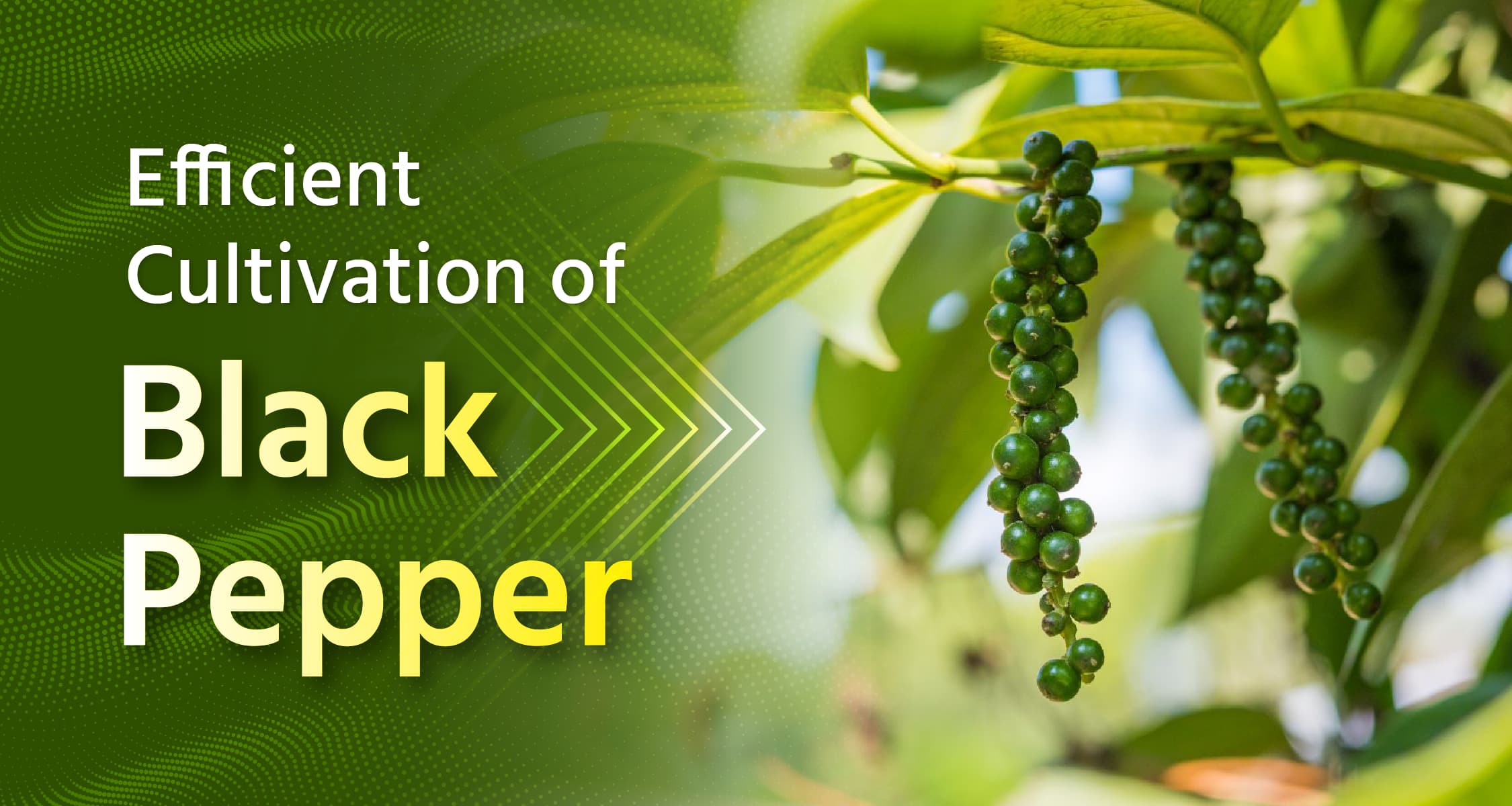पोस्ट विवरण
Efficient Cultivation of Black Pepper

Black pepper is a spice crop that is primarily produced in India. Its cultivation is mainly done in Kerala, Karnataka, and Tamil Nadu in India. Every year, India exports approximately 20 billion worth of black pepper to foreign countries. It contains Vitamin A, Vitamin E, Vitamin K, Vitamin C, Vitamin B6, thiamine, niacin, sodium, and potassium, which boosts immunity. Black pepper protects against colds, coughs, and viral flu. Also, since it is exported from India every year, there is an increasing trend among farmers towards its cultivation nowadays.
How to Cultivate Black Pepper?
- Climate: A hot and humid climate is considered most suitable for the cultivation of black pepper, where the temperature ranges between 20 to 30°C. The black pepper crop can tolerate a minimum temperature of 10.0°C and a maximum of 40.0°C.
- Soil: All types of soil are suitable for black pepper cultivation, but dry, fertile, and red soil is considered the best. The soil should have good water retention capacity to prevent the roots of plants from drying out or getting damaged. The pH value of the soil for black pepper cultivation should be between 5 to 6.5.
- Suitable Time: According to experts, September is considered a good time for sowing black pepper. It can be planted either by cutting or by transplanting.
- Efficient Varieties: Improved varieties of black pepper include Panniyur 1, Panniyur 2, Panniyur 3, Panniyur 4, Panniyur 5, Subhakara, Sreekara, Panchami, Pournami, etc.
- Time and Method of Sowing Black Pepper: The appropriate time for transplanting black pepper using cuttings is mid-September. After transplanting, light irrigation should be done. Cuttings are also used for planting black pepper. One or two nodes of the black pepper plant are cut and planted. These nodes are placed in a row, keeping in mind the distance between the rows so that there is enough space between plants. Approximately 666 plants should be planted in one acre. Each plant can yield produce for about 25 to 30 years. The climbing of vines of black pepper is done using poles or wooden supports. Although the black pepper plant can climb up to a height of 30m to 45 m, its vine is allowed to grow only up to a height of 8m to 9m for easy harvesting.
- Irrigation Management: Continuous irrigation should be carried out from November-December months to the end of March in black pepper crops. Then irrigation should be stopped in black pepper when the monsoon arrives. This helps to increase crop yield by up to 50%. In hot weather, irrigation should be done every other day.
- Weed Control: Plow the field twice thoroughly to control weeds in black pepper. Do the first plowing in the month of May-June and the second in October-November. Weeding can also be done in black pepper for better crop growth and higher yield.
Disease Management
- Foot Rot Disease: This is a fungal disease that affects the roots and stems of the plant. It causes yellowing of the leaves and later, the leaves wither. Additionally, black spots appear on the lower stems. For its control, consult agri-experts and use appropriate fungicides.
- Leaf Spot Disease: This is a disease spread by fungi that affects the leaves, stems, and fruits of black pepper. Small, round spots appear on the leaves and fruits, which later turn brown or black. For its control, consult agri-experts and use appropriate fungicides.
Pest Management
- Mealybugs: These are small, white insects that live on plant sap. These insects suck the juice of the leaves, causing them to turn yellow, and their growth is stunted. Additionally, a sticky residue is released on the plant. To control them, one can use appropriate pesticides under the guidance of agri-experts.
- Thrips: These are tiny sucking insects that feed on the sap of leaves and flowers. As a result, silver scars appear on the leaves and flowers. To control them, one can use appropriate pesticides under the guidance of agri-experts.
- Whiteflies: These white flies suck the sap of plants, causing the leaves to turn yellow, the growth of the plants is delayed, and a sticky residue is released on the plants. Proper pesticides can be used to control this pest under the guidance of agri-experts.
What kind of challenges do you face while cultivating black pepper? Share your answer and experience with us by commenting. Follow the 'Krishi Gyan' channel now for more such interesting and important information. Don't forget to like and share the post with fellow farmers.
Frequently Asked Questions (FAQs)
Q: In which month is black pepper farming done?
A: The transplantation of black pepper plants is done in the month of September, during which the weather is humid and there is also rainfall. Therefore, this is the most suitable time.
Q: How many days does it take for a black pepper plant to bear fruit?
A: A black pepper plant starts yielding produce approximately 3 years after transplanting. About 1kg of black pepper is harvested from one plant every year.
Q: How to grow black pepper seeds?
A: Take seeds of good quality black pepper and then mix them well with organic fertilizer in a seeding tray. Then sow the seeds in a pot to a depth of about ½ inch and water it. Place the pot in an area where there is abundant sunlight.
जारी रखने के लिए कृपया लॉगिन करें

फसल चिकित्सक से मुफ़्त सलाह पाएँ
